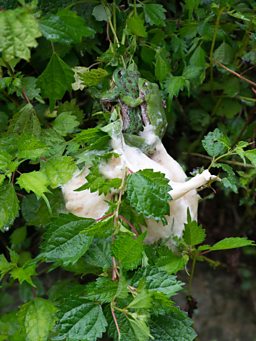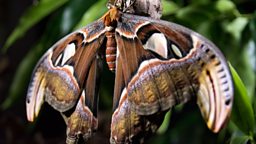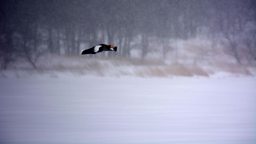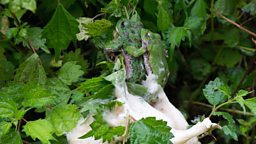The sneaky breeder
Gavin Maxwell: Producer
In a land full of natural wonders, the Japanese tree frog must be one of the prime contenders. Every summer, as fresh shoots of rice appear in the water-filled paddies, foam balls – the size of a grapefruit – appear on the branches of overhanging trees. They’re tree frog nests, and overnight a tree can become festooned with dozens of them. A female tree frog pairs with a male and constructs the nest by rubbing her legs and secreting an albumen-like substance, into which she lays hundreds of eggs. The eggs incubate here, safe in the trees away from predators, and insulated from excessive heat from the sun. When the tadpoles are sufficiently developed they drop out of the nest into the nursery paddy pools below. However whilst the nests are very visible, the frogs and their nest-building are less so – and this is what we planned to film.
It was very wet, and overcast – in the dim light we found a female with a male at the edge of a branch starting to build a nest
The frogs are so well camouflaged in the trees it’s almost impossible to see them. We spent hours finding a suitable elevation on the side of a bank so we could at least sit eye-to-eye should a frog appear. It’s amazing how long you can stare at a branch and convince yourself there’s nothing there, only for your eyes to re-adjust, or the light to change and there - lo and behold - is a tree frog calmly sitting watching you with her unflinching gaze: she’s been there all along! Nothing happens until a few spots of rain start to fall: all of a sudden she will open her mouth and call – a strange high-pitched barking like sound – triggering a chorus of calls from the surrounding trees: the frogs have been all around us all the time!
We had a few potential sites to monitor for nest building – suitable branches dangling over the water-filled paddy fields. Every morning we would patrol them, just as the sun was rising, but on many mornings we were too late: the frogs prefer to build their nests on wet nights in the hours leading up to dawn, but sometimes the nest-building and mating continues until it’s light enough to film. Time and time again we found nests that had been craftily finished just hours beforehand, but early one morning we got lucky: it was very wet, and overcast – in the dim light we found a female with a male at the edge of a branch starting to build a nest. It was a perfect location for us – we could get close enough without disturbing them, and look across at their level rather than pointing up at the tree-tops.
The nest was positioned perfectly above a rice paddy – the ideal location for filming, but it was also perfect for other male frogs too: soon there were three additional males joining in. This is no accident: it’s possible for late arrivals to still fertilise some of the eggs – they’re called sneaky breeders! Much to our surprise, the scene rapidly descended into something resembling a Roman orgy. The sight of a mass of amorous frogs writhing around together in slippery foam is one that will stay with me for a while.
It’s possible for late arrivals to still fertilise some of the eggs – they’re called sneaky breeders!
When at last the amorous encounter was over we filmed one sneaky breeder trying to creep quietly away from the party. He clearly hadn’t counted on the consistency of the foam nest: the albumen-like substance is very slippery! His return journey along the branch to the safety of the trees was surprisingly hazardous, slithering and slipping as he tried to venture heroically forth. Unfortunately he was unable to leave with any dignity – in full sight of us (and all the other tree frogs) he slid unceremoniously off the branch and with a resigned ‘plop’ landed in the pool below. At least he was able to rinse off the worst of the slippery foam! Nonetheless, after such a successful and comprehensive performance the tree frog nest duly delivered a clutch of new tadpoles a few weeks’ later, and our sequence was complete.






